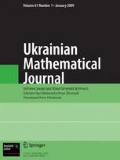We study the existence of maximal subrings and hereditary properties between a ring and its maximal subrings. Some new techniques for establishing the existence of maximal subrings are presented. It is shown that if R is an integral domain and S is a maximal subring of R, then the relation dim(R) = 1 implies that dim(S) = 1 and vice versa if and only if (S : R) = 0. Thus, it is shown that if S is a maximal subring of a Dedekind domain R integrally closed in R; then S is a Dedekind domain if and only if S is Noetherian and (S : R) = 0. We also give some properties of maximal subrings of one-dimensional valuation domains and zero-dimensional rings. Some other hereditary properties, such as semiprimarity, semisimplicity, and regularity are also studied.
Similar content being viewed by others
References
A. Azarang, “On maximal subrings,” Far East J. Math. Sci., 32, No. 1, 107–118 (2009).
A. Azarang and O. A. S. Karamzadeh, “Which fields have no maximal subrings,” Rend. Semin. Mat. Univ. Padova, 126, 213–228 (2011).
A. Azarang and O. A. S. Karamzadeh, “On the existence of maximal subrings in commutative Artinian rings,” J. Algebra Appl., 9, No. 5, 771–778 (2010).
A. Azarang and O. A. S. Karamzadeh, “On maximal subrings of commutative rings,” Algebra Colloq., 19, 1125–1138 (2012).
A. Azarang and O. A. S. Karamzadeh, “Most commutative rings have maximal subrings,” Algebra Colloq., 19, 1139–1154 (2012).
H. E. Bell and F. Guerriero, “Some conditions for finiteness and commutativity of rings,” J. Math. Math. Sci., 13, No. 3, 535–544 (1990).
D. E. Dobbs and J. Shapiro, “A classification of the minimal ring extensions of an integral domain,” J. Algebra, 305, 185–193 (2006).
D. Ferrand and J.-P. Olivier, “Homomorphismes minimaux danneaux,” J. Algebra, 16, 461–471 (1970).
I. Kaplansky, Commutative Rings, Univ. Chicago Press, Chicago (1974).
O. A. S.Karamzadeh and M. Motamedi, “a-Noetherian and Artinian modules,” Comm. Algebra, 23, No. 10, 3685–3703 (1995).
T. Y. Lam, Lectures on Modules and Rings, Springer-Verlag (1998).
M. L. Modica, Maximal Subrings, Ph. D. Dissertation, University of Chicago (1975).
Author information
Authors and Affiliations
Additional information
Published in Ukrains’kyi Matematychnyi Zhurnal, Vol. 65, No. 7, pp. 883–893, July, 2013.
Rights and permissions
About this article
Cite this article
Azarang, A., Karamzadeh, O.A.S. & Namazi, A. Hereditary Properties between a Ring and its Maximal Subrings. Ukr Math J 65, 981–994 (2013). https://doi.org/10.1007/s11253-013-0836-0
Received:
Published:
Issue Date:
DOI: https://doi.org/10.1007/s11253-013-0836-0



